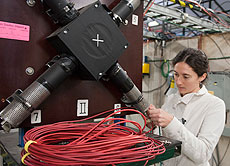Hands-on EDIT school a success
 |
| EDIT school participant Lauren Jeanty works on her group's detector at the Fermilab Test Beam Facility. Photo: Reidar Hahn
|
Arms heavy with a coil of wires, Laura Jeanty, a Harvard University student, scrambled to plug her group's particle detector in before time ran out. Here, at the Fermilab Test Beam Facility, Jeanty and her group would soon test their detector in an actual beam – a valuable learning experience found only at the EDIT school.
From Feb. 13 to today, 64 international EDIT students have been gaining a in-depth understanding of detectors and instrumentation technologies.
The intensive hands-on approach stems from feedback at the first school at CERN. With the success of the two EDIT schools and the promise of a future one at the Japanese laboratory KEK next year, organizers are continually improving this enormously popular approach.
"You get to see the whole spectrum of the detector," said PPD's Doug Jensen, explaining how students first examine a wire chamber in pieces before studying another one that is set up and connected to actual readout from the test beam.
"You get a frame with the first experience. Then you hang things on it until you get the full picture. And you build experience through multiple exposures," he said. "Students coming directly onto a big detector can never really get their hands dirty like this."
As he spoke, about eight EDIT attendees behind him worked in pairs alongside teaching assistants. Carsten Hast, an instructor from SLAC, oversaw two students rewiring a cosmic-ray test stand.
"Let's crank up the voltage," Hast said. Hesitant, one student reached for a control knob and slowly turned.
At another station, Kondo Gnanvo, a volunteer researcher from the University of Virginia, responded to students' questions. They pointed to a screen displaying four histographs that contained the steep spikes of a gas electron multiplier readout.
"We're showing different technology and how it works," Gnanvo, eagerly smiling, said of the school. "And I'm learning a lot as well."
The following week, Laura Jeanty's group shifted to the SiDet building, where the students monitored silicon, germanium and liquid scintillator detectors as they reacted to different sources. One of her favorite exercises, she explained, involved vacuuming the air for half an hour to collect radon samples in order to study the particles decaying from them. Jeanty, like other students, took few breaks from her work, packing in as much time as possible with the instruments.
"I've been waiting to do a program like this but couldn't earlier in my grad career because there wasn't a school like this," she said. "I'm continually impressed with the amount of effort and time invested by the organizers."
—Brad Hooker
|